Panama city(Panama) 作者: 来源: 发布时间:2021-06-03
1. Population and Area
Panama City (Spanish: Ciudad de Panamá ), also simply known as Panama, is the capital and largest city of Panama. It has an urban population of 880,691, with over 1.5 million in its metropolitan area. The city is located at the Pacificentrance of the Panama Canal, in the province of Panama.
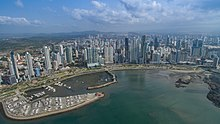
2. Geography
Panamá is located between the Pacific Ocean and tropical rain forest in the northern part of Panama. The Parque Natural Metropolitano(Metropolitan Nature Park), stretching from Panama City along the Panama Canal, has unique bird species and other animals, such as tapir, puma, and caimans. At the Pacific entrance of the canal is the Centro de Exhibiciones Marinas (Marine Exhibitions Center), a research center for those interested in tropical marine life and ecology, managed by the Smithsonian Tropical Research Institute.
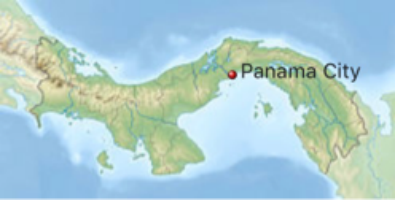
Tropical forests around Panama are vital for the functioning of the Panama Canal, providing it with the water required for its operation. Due to the canal's importance to the Panamanian economy, tropical forests around the canal have been kept in an almost pristine state; the canal is thus a rare example of a vast engineering project in the middle of a forest that helped to preserve that forest. Along the western side of the canal is the Parque Nacional Soberanía (Sovereignty National Park), which includes the Summit botanical gardens and a zoo. The best known trail in this national park is Pipeline Road, popular among birdwatchers.
Nearly 500 rivers lace Panama's rugged landscape. Most are unnavigable; many originate as swift highland streams, meander in valleys, and form coastal deltas. However, the Río Chepo and the Río Chagres, both within the boundaries of the city, work as sources of hydroelectric power.
The Río Chagres is one of the longest and most vital of the approximately 150 rivers that flow into the Caribbean. Part of this river was dammed to create Gatun Lake, which forms a major part of the transit route between the locks near each end of the canal. Both Gatun Lake and Madden Lake (also filled with water from the Río Chagres) provide hydroelectricity to the former Canal Zone area. The Río Chepo, another major source of hydroelectric power, is one of the more than 300 rivers emptying into the Pacific.
Transportation: Panama's international airport, Tocumen International Airport is located on the eastern outskirts of the city's metropolitan area. Two other airports serve Panama City: Panamá Pacífico, previously the Howard Air Force Base, and Marcos A. Gelabert, previously the Albrook Air Force Base. Pacífico serves Wingo, while Marcos A. Gelabert Airport is the main hub for AirPanama. Most other flights are served by Tocumen.
There are frequent traffic jams in Panama City due to the high levels of private transport ownership per kilometre of traffic lane. In an attempt to curb traffic jams, President Ricardo Martinelli has brought forward the citywide Panama Metro, initially 14 km (9 mi) long, stretching across the city. This was allowed thanks to an increase in tax rates.
The bus terminal located in Ancon offers buses in and out of the city. Bus service is one of the most widely used forms of transportation in Panama. The terminal receives thousands of passengers daily from locations like David, Chiriqui, and the central provinces of Herrera and Los Santos. The terminal also receives international passengers from Central America via the Pan-American Highway.
Panama City offers transportation services through yellow taxis. Taxis do not use a meter to measure fares, instead using a zone system for fares that is published by the Autoridad de Transito y Transporte Terrestre, Panama's transit authority. Taxis used to be red. Taxi drivers that charge more than usual are not uncommon. Many also participate in InDriver and Cabify. Uber has been the subject of controversy, with many taxi drivers demanding its cessation of operations in Panama City.
3.Economy
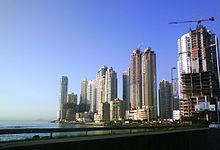
Construction boom in Panama City.
As the economic and financial center of the country, Panama City's economy is service-based, heavily weighted toward banking, commerce, and tourism. The economy depends significantly on trade and shipping activities associated with the Panama Canal and port facilities located in Balboa. Panama's status as a convergence zone for capital from around the world due to the canal helped the city establish itself as a prime location for offshore banking and tax planning. Consequently, the economy has relied on accountants and lawyers who help global corporations navigate the regulatory landscape. The city has benefited from significant economic growth in recent years, mainly due to the ongoing expansion of the Panama Canal, an increase in real estate investment, and a relatively stable banking sector. There are around eighty banks in the city, at least fifteen of which are local.
Panama City is responsible for the production of approximately 55% of the country's GDP. This is because most Panamanian businesses and premises are located in the city and its metro area. It is a stopover for other destinations in the country, as well as a transit point and tourist destination in itself.
4. Industry
Tourism is one of the most important economic activities in terms of revenue generation. This sector of the economy has seen a great deal of growth since the transfer of the Panama Canal Zone at the end of the twentieth century. The number of hotel rooms increased by more than ten-fold, from 1,400 in 1997 to more than 15,000 in 2013, while the number of annual visitors increased from 457,000 in 1999 to 1.4 million in 2011. The city's hotel occupancy rate has always been relatively high, reaching the second highest for any city outside the United States in 2008, after Perth, Australia, and followed by Dubai. However, hotel occupancy rates have dropped since 2009, probably due to the opening of many new luxury hotels. Several international hotel chains, such as Le Méridien, Radisson, and RIU, have opened or plan to open new hotels in the city, along with those previously operating under Marriott, Sheraton, InterContinental, and other foreign and local brands. The Trump Organization built the Trump Ocean Club, its first investment in Latin America, in 2006 and it is the tallest building in the city. In 2018 it was renamed The Bahia Grand Panama following falling occupancy rates associated with the declining brand value of the Trump name. Hilton Worldwide opened a Hilton Garden Inn in El Cangrejo, and in 2013, The Panamera, the second Waldorf Astoria Hotel in Latin America.
5. Landmarks
Tourism in Panama City includes many different historic sites and locations related to the operation of the Panama Canal. A few of these sites are the following:
·Las Bóvedas ("The Vaults"), a waterfront promenade jutting out into the Pacific;
·The National Institute of Culture Building and the French embassy across from it;
·The Cathedral at Plaza de la Catedral;
·Teatro Nacional (National Theatre of Panama), an intimate performance center with outstanding natural acoustics and seating for about 800 guests;
·Museo del Canal Interoceánico (Interoceanic Canal Museum); and
·Palacio de las Garzas (Heron's Palace), the official name of the presidential palace, named for the numerous herons that inhabit the building.
·Miraflores Visitors Center at the Miraflores set of Locks on the Pacific Side, with a museum and a simulator of a ship cruising the canal.
·Calzada de Amador (Amador Causeway), a land-bridge built with rocks excavated during the construction of the Panama Canal.
In addition to these tourist attractions, Panama City offers many different options when it comes to hotel accommodations, including the first Waldorf Astoria hotel to open in Latin America, and many small boutique style hotels that have smaller numbers of guest rooms and offer a more intimate vacation. Nightlife in the city is centered around the Calle Uruguay and Casco Viejo neighborhoods. These neighborhoods contain a variety of different bars and nightclubs that cater to the tourists visiting the city.
One of the newer tourist areas of the city is the area immediately east of the Pacific entrance of the canal, known as the Amador Causeway. This area is currently being developed as a tourist center and nightlife destination. The Smithsonian Tropical Research Institute operates a station and a small museum open to the public at Culebra Point on the island of Naos. A new museum, the Biomuseo, was recently completed on the causeway in 2014. It was designed by the American architect Frank Gehry, famous for the Guggenheim Museum Bilbao and the Disney Concert Hall in Los Angeles. Just outside the city limits is the Parque Municipal Summit. A new convention center called the Amador Convention Center is being built in Amador by CSCEC in a joint venture with a Panamanian company called CCG Cocige. The Panamanian ministry of Tourism hopes for the convention center to house 100 international events annually. There were plans (proposed by Panamanian president Juan Carlos Varela) to build in Amador a campus for the embassy of the People's Republic of China in Panama, however the plans were eventually dropped, due to criticism from the general public and fears that tourists could easily assume that Panama was Chinese territory. Varela in response said that Amador is an area that "must have more value".
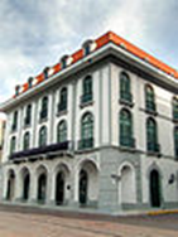
The Interoceanic Canal Museum
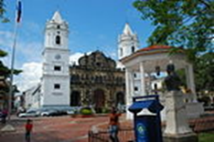
Plaza de la Independencia
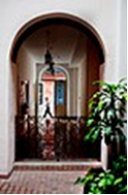
Archway and classic calicanto
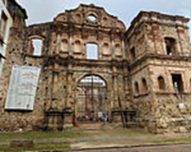
Compañía de Jesús, the ruins of an ancient convent of the Society of Jesus
6. Culture and history
Culture: World Heritage Sites
Panamá Viejo
Panamá Viejo ("Old Panama") is the name used for the architectural vestiges of the Monumental Historic Complex of the first Spanish city founded on the Pacific coast of the Americas by Pedro Arias de Avila on 15 August, 1519. This city was the starting point for the expeditions that conquered the Inca Empire in Peru in 1532. It was a stopover point on one of the most important trade routes in the history of the American continent, leading to the famous fairs of Nombre de Dios and Portobelo, where most of the gold and silver that Spain took from the Americas passed through.
Casco Viejo or Casco Antiguo
Built and settled in 1671 after the destruction of Panama Viejo by the privateer Henry Morgan, the historic district of Panama City (known as Casco Viejo, Casco Antiguo or San Felipe) was conceived as a walled city to protect its settlers against future pirate attacks. It was designated a World Heritage Site by UNESCO in 2003.
Casco Antiguo displays a mix of architectural styles that reflect the country's cultural diversity: Caribbean, Republican, art deco, French, and colonial architecture mix in a site comprising around 800 buildings. Most of Panama City's main monuments are located in Casco Antiguo, including the Salón Bolivar, the National Theater (founded in 1908), Las Bóvedas, and Plaza de Francia. There are also many Catholic buildings, such as the Metropolitan Cathedral, the La Merced Church, and the St. Philip Neri Church. The distinctive golden altar at St. Joseph Church was one of the few items saved from Panama Viejo during the 1671 pirate siege. It was buried in mud during the siege and then secretly transported to its present location.
The Cinta Costera 3 in Casco Viejo
Undergoing redevelopment and gentrification, the old quarter has become one of the city's main tourist attractions, second only to the Panama Canal. Both government and private sectors are working on its restoration. President Ricardo Martinelli built an extension to the Cinta Costera maritime highway viaduct in 2014 named "Cinta Costera 3" around the Casco Antiguo.
Before the Cinta Costera 3 project was built there were protests. Much of the controversy surrounding the project involved the possibility that Casco Viejo would lose its World Heritage status. On 28 June 2012, UNESCO decided that Casco Viejo will not be put on the List of World Heritage Sites in Danger.
History:
The city of Panama was founded on 15 August, 1519, by Spanish conquistador Pedro Arias Dávila. The city was the starting point for expeditions that conquered the Inca Empire in Peru. It was a stopover point on one of the most important trade routes in the American continent, leading to the fairs of Nombre de Dios and Portobelo, through which passed most of the gold and silver that Spain took from the Americas.
On 28 January, 1671, the original city was destroyed by a fire when the privateer Henry Morgan sacked and set fire to it. The city was formally reestablished two years later on 21 January, 1673, on a peninsula located 8 km (5 miles) from the original settlement. The site of the previously devastated city is still in ruins, and is now a popular tourist attraction, and is regularly visited by school trips.
7. Other information
The city is the political and administrative center of the country, as well as a hub for banking and commerce.
8. Contact
Address: Ave. Justo Arosemena y Cuba y entre calles 35 y 36 Este.
Tel: +507 204-1100 +507 506-9700
Website: http://mupa.gob.pa/
Facebook: Municipio de Panama
Twitter: @panamamunicipio
Mayor: José Luis Fábrega
